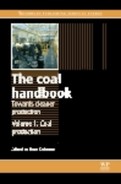Table of Contents
Woodhead Publishing Series in Energy
Part I: Introduction and coal characterization
Chapter 1: Industrial uses of coal
1.2 Coal use in the power generation industry
1.3 Coal use in the steel industry
1.4 Coal use in the cement industry
1.5 Coal conversion and other industries
2.4 Differences in coalification history
2.5 Coal properties and standards for coal classification systems
2.6 Sources of further information and advice
3.2 Macerals and minerals in coal
3.3 Lithotypes, microlithotypes and abnormal conditions found in coal
3.4 The impact of petrographic characteristics on the technological properties of coal
3.5 Development of modern techniques in coal petrographic analysis
Chapter 4: Coal resources and reserves
4.2 Classification of coal resources and reserves
4.3 Calculation of coal resources and reserves
4.4 Reporting of coal resources and reserves
5.2 Accounting for heterogeneity in coal sampling
5.3 Other principles of sampling
6.2 Typical metallurgical (coking) and thermal coal tests
6.11 Further considerations and future trends
6.12 Appendix: standards for coal quality evaluation
Part II: Coal extraction and preparation
Chapter 7: Advances in coal mining technology
7.3 Advances in mining technology
7.6 Future trends and conclusions
Chapter 8: Underground coal gasification
8.2 Lessons learnt from previous trials
8.3 Impact of new technologies
8.5 Conclusion and future trends
Chapter 9: Coal comminution and sizing
9.2 Coal breakers, crushers and sizers
9.3 Coal sizing: an introduction
9.4 Coal screening and classification
Chapter 10: Cleaning of coarse and small coal
10.6 Conclusion and future trends
10.7 Sources of further information and advice
Chapter 11: Cleaning of fine and ultrafine coal
11.3 Froth flotation technologies and circuit variations
11.4 Dry fine coal separations
Chapter 12: Surface chemistry fundamentals in fine coal processing
12.1 Surface properties of coal
12.5 Rheology effects in fine coal processing
Chapter 13: Solid–liquid separation technologies for coal
13.2 Overview of solid–liquid separation (SLS)
13.9 Emerging and future trends
13.11 Sources of further information and advice
14.2 Current steam coal circuit design
14.3 Current metallurgical coal circuit design
Chapter 15: Post-treatment of coal
15.2 Estimating required liberation size
15.3 Milling coal for liberation
15.4 Chemically treating raw coal for liberation
15.13 Appendix: Nomenclature and abbreviations used
Chapter 16: Treatment of coal tailings
16.3 Tailings’ dewatering technologies
16.4 Water recirculation, discharge and process control
16.5 Conclusion and future trends
Chapter 17: Optimization, simulation and control of coal preparation plants
Chapter 18: Supply chain management for bulk materials in the coal industry
18.3 The raw material value chain
18.4 Customer-related management aspects
19.1 Introduction to belt conveyor technology
19.3 Design of large conveyor systems
19.4 Integrated crushing systems
Chapter 20: Coal handling along the supply chain
20.4 Shiploading/unloading and trainloading/ unloading
Chapter 21: Transportation by rail and sea in the coal industry
21.1 Introduction: the coal transportation system
21.3 Ships and ship loading: fundamental issues
21.4 Achieving high shiploading rates and safe carriage of cargo
21.5 Deballasting and transportable moisture limit (TML)
21.6 Pit-to-port and end-user simulation
21.7 Optimization of existing facilities
21.8 Delivery–cycle challenges
21.10 Trends in terminal developments
21.11 Coal port and shipping route projects in planning or progress
